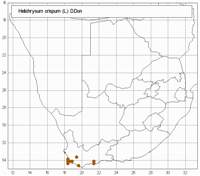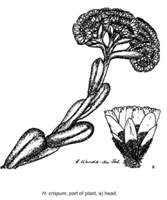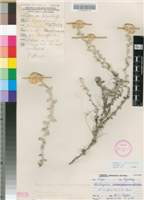Common names:
Hottentotskooigoed, -kruie, kooigoed (A).
Origin of name:
crispus /-a/-um = finely wavy or curled
Diagnostic characters:
Small heads in large, compact inflorescencesPlant covered in white wooly hairsPale yellow bracts
Description:
Perennial herb with tufts of soft-wooded simple or branched stems up to 600 mm long, 4 mm diam., erect or spreading from the crown, rooting at nodes, tips ascending, white silky-woolly, closely leafy. Leaves often with dwarf axillary branchlets, primary leaves up to 35 x 12 mm, diminishing upwards, spathulate to oblong-obovate, apex obtuse to subacute, apiculate, base broad, half-clasping, soft-textured, both surfaces white silky-woolly. Heads homogamous or rarely heterogamous, campanulate, c. 3�6 x 3.5�5 mm, many in dense terminal corymbose clusters arranged in compact corymbose panicles. Involucral bracts in c. 7 series, outermost short, thinly woolly, others subequal, loosely imbricate, about equaling the flowers, not radiating, obovate, tips almost truncate, markedly crisped-undulate, opaque creamy white. Receptacle scarcely honeycombed. Flowers 12�50, very rarely 3�4 female. Achenes 0.75 mm long, glabrous or with duplex hairs. Pappus bristles many, about equaling corolla, scabrid, bases with patent cilia, not cohering.
Flowering between October and December.
Distribution:
On coastal or inland dunes and other sandy places. Mainly along the Cape coast (but also recorded from Tulbagh Kloof) from Blouberg strand to George.
Fynbos Biome.
Notes:
There is some variation in the size of the heads and the degree of crisping of the involucral bracts, the larger heads often having the bracts less crisped than the smaller. Nevertheless, the species is not easily confused with any other.
Taxonomy:
Literature:
Helichrysum crispum (L.) D. Don in Loudon, Hort. Brit. 341 (1830); Less., Syn. Comp. 310 (1832); Hilliard & Burtt in Notes R. bot. Gdn Edinb. 32: 346 (1973).
Type:
Lectotype: Plukenet, Phytogr. t. 298 fig. 3 (1694), Almagest. 171 (1696), herbarium Sloane 100: folio 104, top left (BM).
Synonym(s):
Gnaphalium crispum L., Sp. Pl. edn 2: 1197 (1762), Mantissa 91 (1767).
G. polyanthos Thunb., Prodr. 151 (1800), non p. 147, Fl. Cap. 657 (1823). G. multiflorum Willd,, Sp. Pl. 3: 1900 (1804); Thunb., Mus. Upsal. Append. 13: 3 (1806). Type: Cape of Good Hope, Thunberg (sheet 19205, UPS).
Helichrysum leucophyllum DC., Prodr. 6: 175 (1838). G. leucophyllum (DC.) Sch. Bip. in Bot. Ztg 3: 169 (1845). Type: Cape, Worcester, Ecklon 1425 (G-DC).
H. crassifolium sensu DC., Prodr. 6: 175 (1838); Harv. in F.C. 3: 224 (1865); Moeser in Bot. Jb. 44: 309 (1910), non (L.) D. Don.
H. rotundifolium sensu Moeser in Bot. Jb. 44: 309 (1910), non (Thunb.) Less.
Vouchers:
Acocks 19075 (PRE); Compton 12782 (NBG); Pillans 9764 (BOL); Rogers 2150a (BOL; PRE); Salter 7079 (BOL; PRE).


_sml.jpg)
_sml.jpg)
_sml.jpg)
_sml.jpg)
_sml.jpg)
_sml.jpg)
